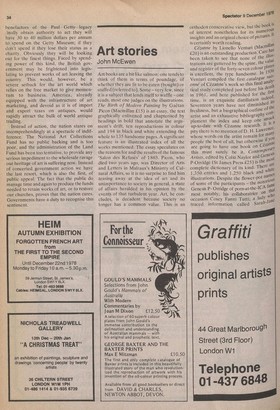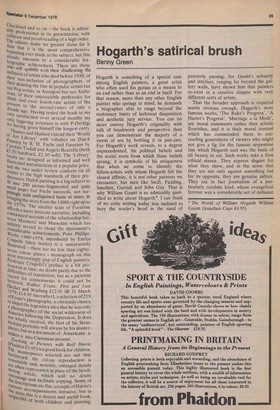Art stories
John McEwen
Art books are a bit like salmon: one tends to think of them in terms of poundage, of whether they are fit to be eaten (bought) or stuffed (referred to). Some — very few, since it is a subject that lends itself to waffle —one reads, most one judges on the illustrations. The Birth of Modern Painting by Gaetan Picon (Macmillan £15) is an essay, the text graphically enlivened and chapterised by headings in bold that annotate the argument's drift, ten reproductions in colour and 194 in black and white extending the whole to 135 handsome pages. A significant feature is an illustrated index of all the works mentioned. The essay speculates on the reasons for and the results of the famous 'Salon des Refuses' of 1863. Picon, who died two years ago, was Director of Arts and Letters in Malraux's Ministry of Cultural Affairs, so it is no surprise to find him leasing away at the idea of art and its unimportance to society in general, a state of affairs heralded in his opinion by the events of that turbulent year. Art, he concludes, is decadent because society no longer has a common value. This is an orthodox conservative view, but the book is of interest nonetheless for its numerous insights and an original choice of pictures. It is certainly worth reading. Cezanne by Lionello Venturi (Macmillan £20) is an outstanding production: Care has been taken to see that none of the illustrations are guttered by the spine, the value and register of the forty-seven colour„ is excellent, the type handsome. In 19-7 Venturi compiled the first catalogue rafs' onne of Cezanne's work so this final analtical study completed just before his death in 1961, and here published for the first time, is an exquisite distillation indee.t1 Seventeen years have not diminished Its freshness, but a biographical outline oft he artist and an exhaustive bibliography eon”; plement the index and keep onestu.ae". up-to-date with Cezanne research. It Is " pity there is no mention of D. H. Lawrence. whose words on the artist remain for rrlanY people the best of all, but otherwise if Y°11 are going to have one book on Cezanue, this must surely be it. Contemporar.) Artists, edited by Colin Naylor and Genesi: P-Orridge (St James Press £25) is the Os complete dictionary of its kind. There are 1,350 entries and 1,250 black and White illustrations. Despite the flower-pot na.Illess of some of the participants — the notorioue Genesis POrridge of porn-at-the-ICA faln. most notably; his collaboratrice on that occasion Cosey Fanni Tutti; a lady vvh° traced information called Sarah sane °nllingering irritation is with P-Orridge Checkland and so on — the book is admirably professional in its presentation, with collation and proof-reading of a high order. The editors make no greater claim for it than that it is the most comprehensive beginning ever made in the subject, but this already amounts to a considerable lexicographic achievement. There are those who will quibble with their disallowing the inclusion of artists who died before 1930, of their non-inclusion of photographers, of their drawing the line at popular artists but not Pop artists, at Annigoni but not Archzcme. of their unavoidable preference for thirdand even fourth-rate artists of the present to the second-raters of only a decade ago. Having tested the book to my Own satisfaction over several months. my for having given himself the longest entry. Thames and Hudson extend their 'World of .Art Library' with volumes on Dutch Painting by R. H. Fuchs and Futurism by Caroline Tisdall and Angelo Bozzolla (both, £5.50 hardback, £2.50 soft). The 'Library books are designed as informed and well illustrated introductions at a popular price, and the two under review conform .on all counts to the high standards of their predecessors. Dutch painting is a big subject to fit into 200 picture-fragmented and quite small pages but Fuchs succeeds, not su.r1).11,51'10Y with undisguised haste at times, in vringing the story from the 1400s right up to the 1970s. The smaller scale of Futurism affords a more intricate narrative, including a Measured account of the relationship between Marinetti and Mussolini which has unfairly served to cloud the movement s considerable achievements. Peter Phillips: IVorks 1960-1974, introduced by Enrico C. rIsPolti (idea books) is a sumptuously Illustrated — there are no less than eightyseven. colour plates — monograph on this Tost interestingly pop of English painters. r.rofessor Crispolti's preface is a bit proI.essorial at time no doubt partly due to the drifficulties of translation, but as a pictorial ,ecord for connoisseurs it could not be oettered. Walker Evans: First and Last (iSecker and Warburg £12.95 till 31 March 279; £14.95 thereafter), a selection of 219 tEvans's photographs, is obviously chosen o dispel the legendary idea that he was only a, Photographer of the social wilderness of merica following the Depression. It does 1 Wholly succeed, the best of his Stem ueckian portraits will always be his masterPieces, but as a document of Americana it Makes a ,pt,onkingiliCaet Christmas present. !itilaid°r1 £3.95` ktures with Rolf Harris is a good book for children. °nllingering irritation is with P-Orridge is a good book for children. harle masterpieces selected are not that r_ekneyed, the colour reproduction .is :casonable and, sensibly, enlarged details deiree 9ften represented in place of the bewilenring whole, which will no courage doubt elnae de : and facilitate copying. Some. of acriptions are flat, a couple of Harris. s Th11 accompaniments intrusive, but in res ram') this is a decent and useful .book, Peetful of both children and painting.















































 Previous page
Previous page